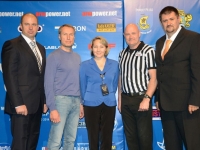Paralympic movement emerged in the 40s of last century.To Russia it came with the Olympic Games 1989. Now Russian Paralympic team is of a very high level. Please tell us about the Federation work specificity.
Russian team worked on Federation together with Ukrainian and Polish colleagues. There was a question about the unique classification system. Thу matter is that the functional classification of athletes exists only in the Paralympic movement and is not used in any sport. According to this classification system in armwrestling we divide athletes into four groups - sports classes for athletes with disabilities. Two classes for athletes with lesions of the musculoskeletal system, one class - for blind athletes and one class - for the deaf. We call these classes ARM1, ARM2, ARM3 and ARM4 respectively. ARM1 is a class for athletes who compete in wheelchairs. The main criterion for getting into ARM1 class is the lack of lack of reliance on both feet like, for example, athletes with spinal cord injury at the level of the thoracic spine, polio athletes, and athletes with a high amputation of both thighs, or with the corresponding limb hypoplasia. ARM2 is a class for athletes who fight standing.
Actually there are 10 types of lesions in the Paralympic movement: eight of them are lesions of the musculoskeletal system, the rest - impaired vision and poor intelligence. We did not take into account the violation of the intellect, and of the eight types of lesions of the musculoskeletal system, we excluded low growth. For the rest the groups have been formed.
Perhaps in the future we will extend the classes at the expense of not encountered lesions, but we do not have special methods of work and rules for such athletes so far.
Each group has its own minimum validity criterion. For example, the minimum criterion for amputees is no leg to the ankle. If the athlete does not meet this criterion, then he gets «not illegible» class. In this championship we had such issue with three athletes - Ukrainian, Brazilian and Indian. They were missing fingers. But we absolutely do not take into account such a criterion, because in armwrestling hands should be healthy by default. We've had a lot of discussion about this, but still we decided not to take these athletes.
Does it actually mean that a «not illegible» class sportsman can fight among healthy?
Yes, he can fight with his healthy hand. And sometimes he can fight even with an injured hand, for example, if it does not have just the 4th and 5th fingers. With the rest of fingers he is able to make a specific grip.
How will armwrestling infuse to the International Paralympic Committee?
The structure of the IPC - International Paralympic Committee - includes those sports federations, which are presented at the Paralympics. But there are also federations recognized by IPC. Among these federations not all the sports are Paralympic, for example, some of them are taekwondo, badminton. We want to take at least this step.
Generally, in order to become Paralympic, sport must meet certain criteria. The first criterion is an acting International Federation. The other two criteria - the sport should be developed in no less than 32 countries in three continents of five (Australia, America, Asia, Europe and Africa). In this championship we had met two criteria - the Federation and three continents. It remains to ensure that the armwrestling for Disabled is introduced in 32 countries. And I hope that wide coverage in the media and live broadcast will help us with it.
Another criterion - a sport must be popular in the world. This means that every year the national championships for the disabled should be conducted. The championships should be confirmed by the protocol. The national team must take part in the World and regional championships.
Can we hope that the Para-Armwrestling will be a locomotive for the healthy Armwrestling?
Yes, of course.
Some countries did not want to participate in this championship. What arguments can be presented in order to convince them?
We had the A1 Tournament, during which fights of disabled took place also. So, everybody watched the fights of disabled athletes just because they had to wait for the healthy stars. I liked the A1 Tournament, but this time here there were very different feelings. Here guys feel like owners of the World Championship and behave differently. They understand that all this is for them. Nice to see how athletes communicate in an informal atmosphere, meet, exchange contacts. I believe that such a federation is very much needed. It should be developed and supported.
Well, in a duel athletes feel quite differently due to the classification and the better weight categories.
So that countries just have to come and participate in such championship.
We, as the World Federation are committed to providing maximum support to all local federations to convince local authorities to contribute to their work.
Regarding Anti-Doping Code - what if the athlete takes illegal drugs for health needs?
First of all, the athlete himself is responsible for what he takes.
At the congress of the Federation, we have created Anti-Doping Committee, which will promote the spread of necessary information, especially of the list of banned drugs. But athletes can be in a condition when use of illegal drugs is inevitable. In this case, the athlete must have a Therapeutic Use of the substance permission- TUE. This permission is given by WADA. The Agency when considering the application of an athlete decides whether to replace the drug with a «clean" or give a permission. For example, insulin-dependent diabetes - an athlete can not live without insulin.
Anastazja Kisilyova

